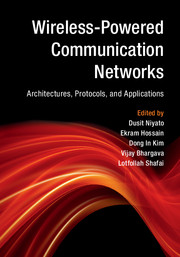Book contents
- Frontmatter
- Contents
- List of contributors
- Preface
- Part I Basics of Wireless Energy Harvesting and Transfer Technology
- 1 Basics of Wireless Energy Harvesting and Transfer
- 2 Circuit Design for Wireless Energy Harvesting
- 3 Antennas for Wireless Energy Harvesting and Massive MIMO Applications
- Part II Architectures, Protocols, and Performance Analysis
- Part III Applications of Wireless Energy Harvesting and Transfer
- Index
- References
1 - Basics of Wireless Energy Harvesting and Transfer
from Part I - Basics of Wireless Energy Harvesting and Transfer Technology
Published online by Cambridge University Press: 01 December 2016
- Frontmatter
- Contents
- List of contributors
- Preface
- Part I Basics of Wireless Energy Harvesting and Transfer Technology
- 1 Basics of Wireless Energy Harvesting and Transfer
- 2 Circuit Design for Wireless Energy Harvesting
- 3 Antennas for Wireless Energy Harvesting and Massive MIMO Applications
- Part II Architectures, Protocols, and Performance Analysis
- Part III Applications of Wireless Energy Harvesting and Transfer
- Index
- References
Summary
Introduction
Energy harvesting is an important aspect of green communication that provides self-sustainable operation of wireless communications systems and networks. Energy harvesting has been adopted in low-power communication devices and sensors. There are different forms of energy harvesting suitable for different applications. Table 1.1 shows the summary of different energy harvesting technologies.
• Photovoltaic technology has been developed over decades, and it is one of the most commonly used energy harvesting techniques. A solar panel which is composed of multiple solar cells converts sunlight into a flow of electrons based on the photovoltaic effect. The effect describes the phenomenon that the light excites electrons into a higher state of energy. The electrons then can act as charge carriers for electric current. A solar cell contains a photovoltaic material, e.g., monocrystalline silicon, polycrystalline silicon, amorphous silicon, and copper indium gallium selenide/sulfide. The efficiency of a solar cell can be up to 43.5%, while the average efficiency of a commercial solar cell is 12%–18%. Photovoltaic technology has been adopted in many applications, including rooftop and building integrated systems, power stations, rural electrification, and telecommunication. However, photovoltaic systems need a large area and cannot supply energy during the night. Moreover, their efficiency depends on the orientation of the solar panel, which can be complicated to optimize. Photovoltaic systems are suitable for static data communication units, e.g., a base station and access point, while their applicability to mobile units, e.g., user equipment, is limited.
• Thermal energy or heat can be converted to electricity using a thermoelectric generator based on the Seebeck effect or Thomson effect. The effect describes the conversion of temperature difference and electricity in thermoelectric devices. While thermoelectric devices are typically used for measuring temperature, recently they have been developed to serve as energy sources. The devices can produce 20–16 μW/cm2 with the human body as a heat source at room temperature. The benefit of thermoelectric devices is the capability of generating energy as long as there is a temperature difference or a heat flow. Additionally, since they do not have any moving parts, they have high reliability. However, the devices are bulky and heavy. Also, they can supply only a small amount of energy, with typical efficiencies of approximately 5%–8%.
- Type
- Chapter
- Information
- Wireless-Powered Communication NetworksArchitectures, Protocols, and Applications, pp. 3 - 43Publisher: Cambridge University PressPrint publication year: 2016
References
- 3
- Cited by



